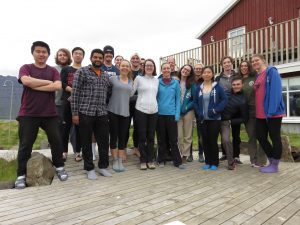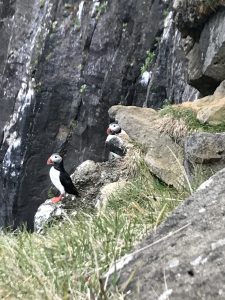Today was the last full day here at Skalanes, a bittersweet kind of day. It started out with a presentation from Òli, who is currently working on his dissertation on the subject of the sustainability of Skalanes. The work here at Skalanes has taken several years, Òli bought the property for tourism and conservation but it has transformed into a multidisciplinary project. They have planted trees in hopes to offer a habitat for further avian species and to offset carbon. They have included students in the efforts to converse, not just to take data but to use that data in order to pursue more sustainable living and offer a more holistic habitat for the wildlife. This place continues to pursue better ways of living sustainably, including pursuing measures now for future events (like global warming).
After the presentation, we split up. Drone people did some flying. Soil and bio people packed up our bio boxes, which was quick and painless. After removing some tubes and gloves that we are keeping here, it was surprising to see how much space there was in the boxes compared to the packing job coming here.
Then we all did our own things, it was a relaxing afternoon. Around 2-3 Sydney recruited me for another batch of banana bread. We had 19 bananas, resulting in two large regular pans, one gluten frene tinto pan, and another small pan (cuz I accidentally made the intended GF bread with real flower first). In the end, the bread ended up being delicious as dessert. Joyce madre Curry, which was so very good.
 After dinner we all gathered together for group photos, a couple with the Glasgow crew and a couple with the gorgeous “Takk Fyrir” sign that Sydney drew to thank Òli and Rannveig. This was followed by our nightly group meeting (rest of trip logistics), then a trip to see the puffins by several of us. We were able to get quite close, they adorable creatures.
After dinner we all gathered together for group photos, a couple with the Glasgow crew and a couple with the gorgeous “Takk Fyrir” sign that Sydney drew to thank Òli and Rannveig. This was followed by our nightly group meeting (rest of trip logistics), then a trip to see the puffins by several of us. We were able to get quite close, they adorable creatures.
All in all it was a good last day. Excited to go back to Reykjavik, but going to miss this little piece of heaven.
